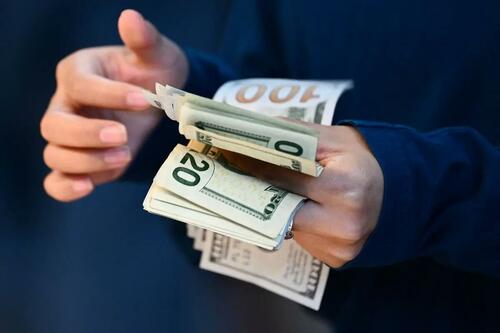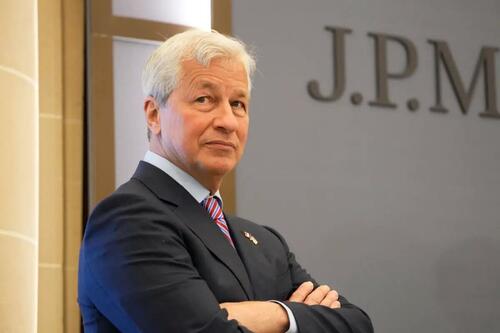More Americans Tapping Into Retirement Savings As ‘Hardship’ Withdrawals Rise
Authored by Tom Ozimek via The Epoch Times (emphasis ours),
A significant jump in the number of Americans yanking money out of their 401(k) accounts to pay bills and buy necessities is the latest sign that the U.S. consumer is experiencing increasing levels of financial strain.
A new report from Fidelity, the nation’s largest provider of 401(k) plans, reveals a troubling trend—Americans are increasingly tapping their retirement savings in the form of hardship withdrawals and loans.
The report shows that 2.3 percent of U.S. retirement plan participants took a hardship withdrawal in the third quarter of 2023, up from 1.8 percent in the third quarter of 2022.
Top reasons given for taking a hardship withdrawal were avoiding foreclosure or eviction and covering medical expenses.
Besides hardship withdrawals, there was also an increase in the number of Americans taking loans from their retirement savings accounts, with this share growing from 2.4 percent in the third quarter of 2023 to 2.8 percent in the comparable period in the prior year.
Inflation continued to be a major concern in the third quarter, with nearly three-quarters of employees indicating that inflation was causing them stress.
The latest findings from Fidelity builds on a recent report from the Bank of America (BofA), which similarly showed that hardship withdrawals rose significantly in the third quarter, and while the BofA didn’t track the specific reasons for the withdrawals, the current state of the economy—including persistently high inflation—is a likely culprit.
Wages Not Keeping Up With Inflation
Among employed Americans, 60 percent said their incomes haven’t kept up with increases in household expenses due to inflation over the past 12 months, according to a new survey from Bankrate. That’s up from 55 percent last year.
Meanwhile, less than one-third (29 percent) said their pay has kept up with or exceeded inflation this year compared to 33 percent last year, and 11 percent say they don’t know.
“The job market has lost some of its steam since the Federal Reserve began raising interest rates to quell inflation, but not much,” Bankrate analyst Sarah Foster told The Epoch Times in an emailed statement.
“The share of workers who got a raise in the past year is matching last year’s historic levels, and more Americans are getting raises today than they were before the pandemic. Even so, inflation remains painfully high for many households, eroding those gains.
“High inflation feels a bit like taking a pay cut in itself, and it might be one reason why Americans suggest the economy isn’t as strong as it looks on paper.”
The U.S. economy grew at a 5.2 percent annualized rate in the third quarter, a forecast-beating pace that some analysts said looks better on paper than in reality because, when looked at from the income side, the data suggests momentum has waned, and growth is slowing.
While gross domestic product (GDP) grew by 5.2 percent, gross domestic income (GDI) grew at a paltry pace of 1.5 percent in the prior quarter.
Market analyst Stephanie Pomboy took to X, formerly Twitter, to note that the difference between GDP and GDI in the third quarter was the widest on record.
“Don’t Believe the Hype,” she wrote. “Widest gap between GDI and GDP in history.”
“The numbers should match and do correlate over time. But the difference between the measures is stunning,” analyst Mike Shedlock wrote in a blog post, referring to the difference between GDP and GDI.
“The key takeaway from this release is the economy likely is not humming the way media and [President Joe] Biden present,” Mr. Shedlock added.
Inflation Fears Resurge
American consumers have grown more pessimistic as inflation concerns recently surged to a 22-year high, flashing a warning sign for the U.S. economy.
The University of Michigan’s closely watched consumer sentiment gauge fell by 4 percentage points in November to a reading of 61.3 percent.
The drop marks the fourth consecutive month of declines in the sentiment measure, with the deepening confidence slump coming as the twin geopolitical crises in Ukraine and Gaza show no sign of ending anytime soon.

Meanwhile, inflation expectations jumped for both the near and long term, reflecting consumer fears that the recent easing of price pressures would be short-lived.
U.S. consumers expect inflation to average 4.5 percent over the next 12 months and 3.2 in the next five years, according to the University of Michigan survey. That’s up from the 4.2 percent and 3 percent, respectively, that consumers predicted when asked in October.
In particular, the five-year inflation expectation reading is the highest in 22 years.
“Consumers appear worried that the softening of inflation could reverse in the months and years ahead,” Joanne Hsu, University of Michigan Surveys of Consumers director, said in a statement.
The jump in inflation expectations comes despite the fact that the consumer price index (CPI), a measure of inflation, fell to 3.2 percent in October from 3.7 percent in September.
A separate measure of consumer confidence, issued by The Conference Board on Nov. 28, shows a slight improvement in sentiment, with the gauge rising to 77.8 in November from 72.7 in October.
Still, any readings below 80 in The Conference Board measure historically signal a recession within the next year, so the improvement in sentiment is limited.
Recession Warnings Abound
Recent data from October show that while 69 percent of U.S. consumers expect a recession over the next 12 months, a whopping 84 percent of C-suite executives believe a contraction will materialize.
While there’s been some encouraging economic data since then, including on employment and inflation, it’s unlikely the numbers have changed all that much in the past two months—at least if JPMorgan CEO Jamie Dimon’s recent remarks are anything to go by.
Mr. Dimon recently warned that inflation could accelerate again and that a recession could well hit the country if the Federal Reserve raises interest rates in response to resurging price pressures.
“A lot of things out there are dangerous and inflationary. Be prepared,” Mr. Dimon said at the 2023 New York Times DealBook Summit in New York on Nov. 29.
Mr. Dimon said that geopolitical tensions and the energy transition were prompting governments to ramp up spending, which is inflationary. If a new inflationary spike were to materialize, this would pressure the Fed to raise interest rates further, which could tip the economy into a downturn.
“Interest rates may go up, and that might lead to recession,” Mr. Dimon said while expressing caution about the economy, especially the effect that inflation has had on U.S. households.
Like other business leaders before him, Mr. Dimon said that stimulus cash doled out during the COVID-19 pandemic bolstered consumer spending and propped up the economy, but its effects are fading.
He added that the Fed’s fast pace of raising interest rates (which went from zero to more than 5 percent at the quickest pace since the 1980s), along with a reversal of its quantitative easing program, were putting a squeeze on the economy and consumers.
Tyler Durden
Mon, 12/04/2023 – 07:20
via ZeroHedge News https://ift.tt/UGfh8Sq Tyler Durden

